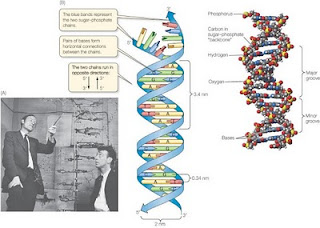DNA is present in the chromosomes of the nucleus i.e. nuclear reticulum. DNA is double stranded molecule. DNA is controlling centre of vital activities of the cell. DNA is genetic or hereditary material migrating intact from generation to generation through reproductive units or gametes and is responsible for the development of specific characters. It also controls biosynthetic processes of cell including protein synthesis. DNA molecule is very large and complex (macromolecule) forming the backbone of each chromosome. In 1953 Watson and Crick worked out a model of DNA molecule and the model was named by their name i.e. ‘Watson Crick Model of DNA’. According to them DNA occurs as double stranded molecule with two strands profusely coiled and entwined about each other throughout their whole length. The structure is like a ladder twisted spirally. Each spiral strand is made of groups of deoxyribose sugar alternating with groups of phosphate. Besides there are infinite pairs of cross links connecting two strands. Each pair is made of two distinct nitrogenous bases Purines and Pyrimidines. Altogether there are two purines adenine and guanine and two pyrimidines thymine and cytosine. It is rule that specific Purine always pairs with specific Pyrimidine. The base molecule of two strands are joined together by weak Hydrogen bonds to form base pairs. Although hydrogen bonds between base pairs of two strands are weak, their large number ensures that two strands are held together by fair degree of firmness. This arrangement gives to DNA molecule ladder like appearance. The ride rails or longer banisters of ladder which form the backbone of DNA super-molecule are formed by alternating sugar and phosphate groups bound by strong chemical bonds. The base pairs form the rungs or horizontal steps of the ladder. This ladder is however not straight. As convinced by Watson Crick, two strands of DNA molecule are twisted about each other at intervals around a central axis to form double helix, something like a spiral circular stair case.
Structure of DNA:
There may be thousands of turns in the spiral. Two strands of DNA travel in opposite direction. In other words they are of opposite polarity. Purine Adenine is always paired with Pyrimidine thymine by two hydrogen bonds and Purine Guanine is always paired with Pyrimidine Cytosine by three hydrogen bonds. This means that Adenine is complimentary to thymine and guanine is complementary to cytosine. If the base sequence in one strand of DNA is known the sequence of bases in the other strand can be determined because two strands are complementary to each other. If at any point on one strand there is adenine, there is bound to be thymine at the corresponding point on the other strand. Total molar amount of adenine in DNA of given species is always equal to that of thymine (A = T) and the same 1:1 relation holds well between guanine and cytosine (G = C). As a corollary it is also true that A + G = T + C.
In other words total numbers of DNA Purines is always equal to total number of DNA Pyrimidines.
Watson Crick Model of DNA:
DNA of different species shows great variations in their A + T and G + C content. This due to the fact that different specimens of DNA vary greatly in the types or frequencies of the bases present along with length of the molecule. They also differ in the sequence of base pairs along great length of DNA double helix. Base pairs can be arranged in any sequence. The number of possible base sequences is equal to 4n where n equals to the number of nucleotides per strand. This gives infinite variety in DNA molecule, each different for different species. That is why there are many kind of DNA, each peculiar to a particular species. Each strand of DNA molecule completes one spiral in length of 34A and each complete spiral contains 10 base pairs. This means that each nucleotide occupies 3.4A along with the length of a strand. Two strands have diameter of about 20A (radius 10A)
A = Angestron = 1 / 10,000µ).







0 Comments